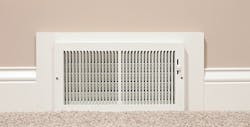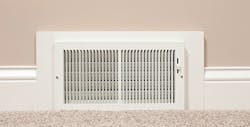Worldwide factory and distributor shutdowns, and transportations restrictions due to COVID-19 have caused a shortage of commercial and residential parts and equipment, including even some indoor air quality products (IAQ).
It's time to go back to doing for customers what I've always considered the most cost-effective way for people to lower their heating and cooling costs and increase their comfort, which to clean and renovate their existing equipment, improve their air distribution system, and add whatever IAQ is available.
Address their ductworkThere's a lot of money to be made in ductwork and there is less of a shortage in materials to make ductwork. The more involved you get in ductwork, the more money you'll make. I know two companies quite well who got all their salespeople, and even some of their technicians, trained on how to recognize duct issues, and how to test and price out replacement duct systems. They went to the expense of putting duct testing equipment in all their vehicles. When these people were called to quote replacement equipment, when it was appropriate and truthful to say this, they told customers that they can replace their equipment, but that won't solve their comfort issues, and that the problems with their duct systems were what caused the mechanical issues with their equipment. What they really
Nearly every system out there is short on return, so train your people on how to price returns air runs.
Additionally, this also give you the ability to provide meaningful work for your installers, so you'll be able to keep them onboard without having to go through the struggle of trying to force them to become tune-up techs or do other things they don't want to do anyway.
Add more air returns
Nearly every system out there is short on return, so train your people on how to price returns air runs.
Just about every customer thinks they need a bigger system. What most systems really need is a good cleaning and more return air.
Just about every customer thinks they need a bigger system. What most systems really need is a good cleaning and more return air.
You sell return air by getting the blower running, then removing the blower door. Unless the system is so short on supply air that the system shouldn't even be running anyway, or they've got a completely impacted evaporator coil, there should be an immediate increase in airflow.
Price absolutely everything out before you do this because there will also be an immediate emotional response from the customer. When I've done this, in most cases, customers have come running, asking, "What did you just do?"
Duct cleaning requires no parts
You don't have to sell a complete duct system every time. There's plenty of money to be made in duct cleaning, and that requires no parts. There people whose entire income is duct cleaning. I've sold a lot of duct cleaning in my day. It's such an easy sale to make that I won't even tell you my closing percentage on it because it's too high to be believable.
Nearly every system, including both the mechanical parts and the ductwork, is dirty and in need of cleaning. Show customers the dirt in their system with a fiber optic camera. They now have inexpensive fiber optic cameras that attach to your cell phone.
You can use those fiber optic cameras to show them cracks in their heat exchangers and their dirty evaporator coil as well.
The first time a contractor brought a fiber optic camera to my home just show it to me, I had him stick it in my ductwork. With no intention of being dramatic just to prove a point, I had an immediate emotional response and shouted, "Get that ductwork out of here!" I had the ductwork replaced (along with the equipment and had IAQ installed) and the chronic allergies that had plagued me for 28 years suddenly disappeared.
If you don't have a fiber optic camera, you can start showing people how dirty and smelly their duct systems are by simply placing a disposal glove over your hand and rubbing it in their return. Let them smell it and they'll want you to clean it for them.
Renovate their existing system
Everyone wants to make the big sale today, but you actually make more money when you renovate equipment, fix their duct issues, and add IAQ because you get thousands of dollars today, a thousand dollars or more over the next few years servicing their existing equipment and, due to inflation, a higher price on the replacement equipment they buy from you a few years later.
It starts with the blower
I kept actual records on this, and two out of every three calls that I ran, of all types, resulted in a blower pull & clean.
Regardless of the type of call I was running, I made it a point to check the blower wheel. It was usually dirty enough to warrant cleaning.
By the way, that's not dirt on the blower wheel. Dirt does not stink. Dirty blower wheels, coils, and ductwork does. You shed up to 30,000 dead skin cells per hour. The so called "dirt" you see on blower wheels is dead skin cells.
By the way, that's not dirt on the blower wheel. Dirt does not stink. Dirty blower wheels, coils, and ductwork does. You shed up to 30,000 dead skin cells per hour. The so called "dirt" you see on blower wheels is dead skin cells.
Unless there is an unusual set of circumstances, anything that you see on a blower wheel is also on the evap coil and ductwork.
When I saw a blower wheel in need of cleaning, I pulled it out so customers could see it. I've had techs tell me they don't want to pull the blower only to have the customer decline to have it cleaned. My experience has been that, when all I did was told them they had a dirty blower wheel, or shined a flashlight on it while it was still in the blower compartment, or showed them a digital picture of it, I stood a good chance of getting a decline. When I had it out and clearly visible, as we approached their equipment, they'd ask me if I was going to clean it.
UV bulbs are scarce
I still believe in the necessity of having at least one standard UV light shining on the evaporator coil, but I see PCO UV lights as outdated technology. The more modern, long-lasting, maintenance-free solution that works just as well as PCO UV lights, that produces absolutely no ozone, is the needlepoint bi-polar ionization. Global Plasma Solutions and Nu-Calgon manufacture products for both residential and commercial applications. I put one in a moldy old mobile and home the smell went away the first day.
Charlie Greer was voted "Favorite Industry Sales Trainer," has been voted the "HVAC Consultant of the Year" twice, and is a member of the Contracting Business HVAC Hall of Fame. Charlie can do video sales training with your HVAC residential replacement salespeople over the internet. For more information , visit www.hvacprofitboosters.com, or call 1-800-963-HVAC (4822). Email your feedback on this column or your questions to [email protected].
About the Author
Charlie Greer
Owner
Charlie Greer was voted “Favorite Industry Sales Trainer” in 2019 and is the creator of “Tec Daddy’s Service Technician Survival School on DVD,” the video training course that provides you with a year’s worth of weekly sales meetings. For more information on Charlie’s products and services, go to www.hvacprofitboosters.com or call 1-800-963-HVAC (4822). Email your comments or sales questions to [email protected].

